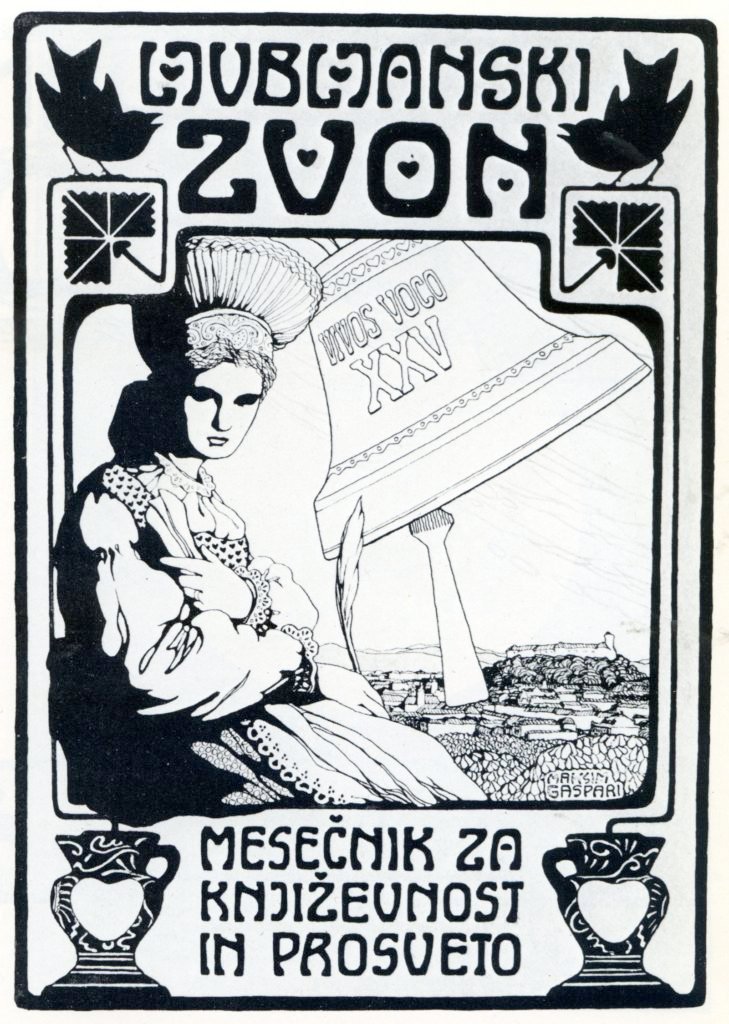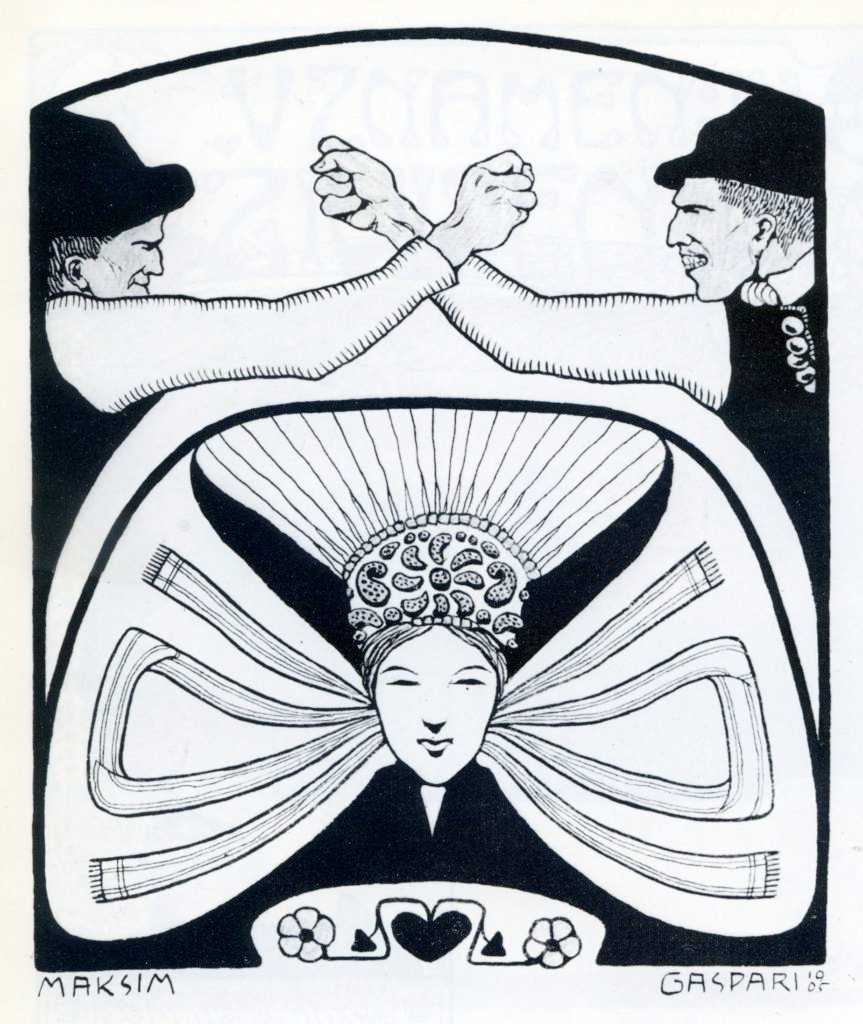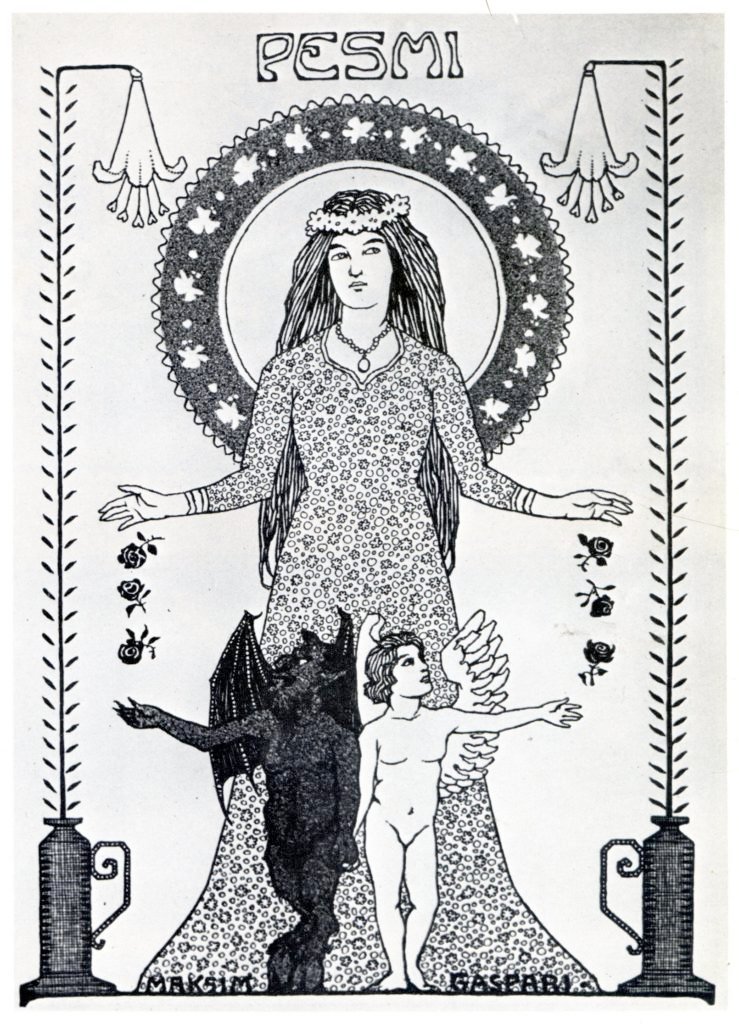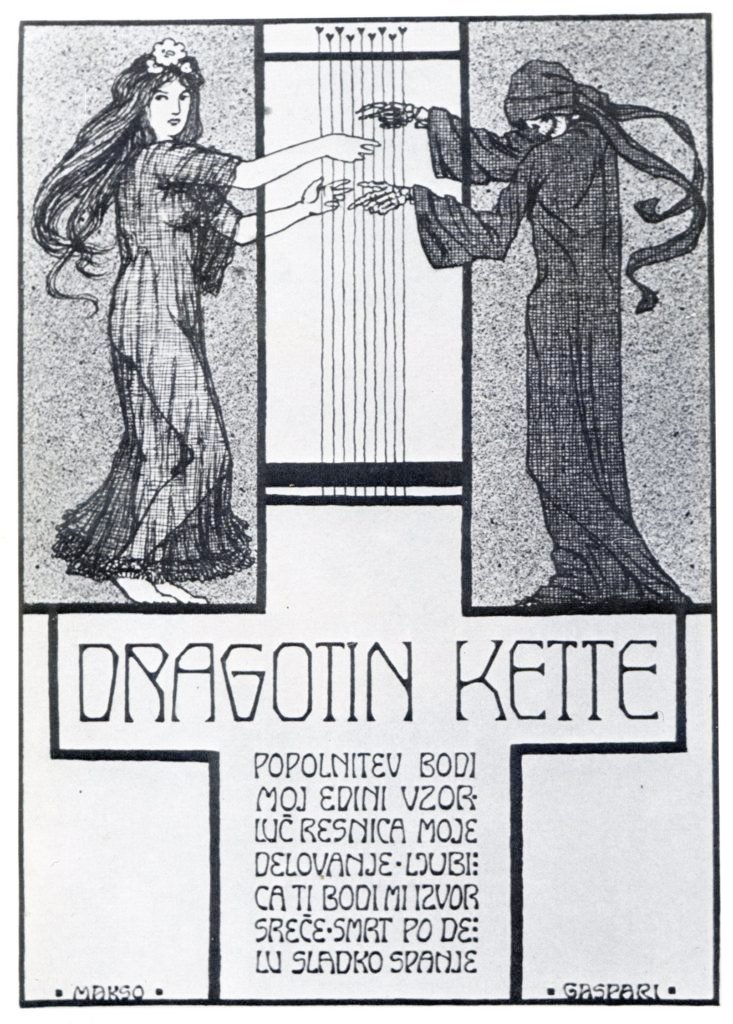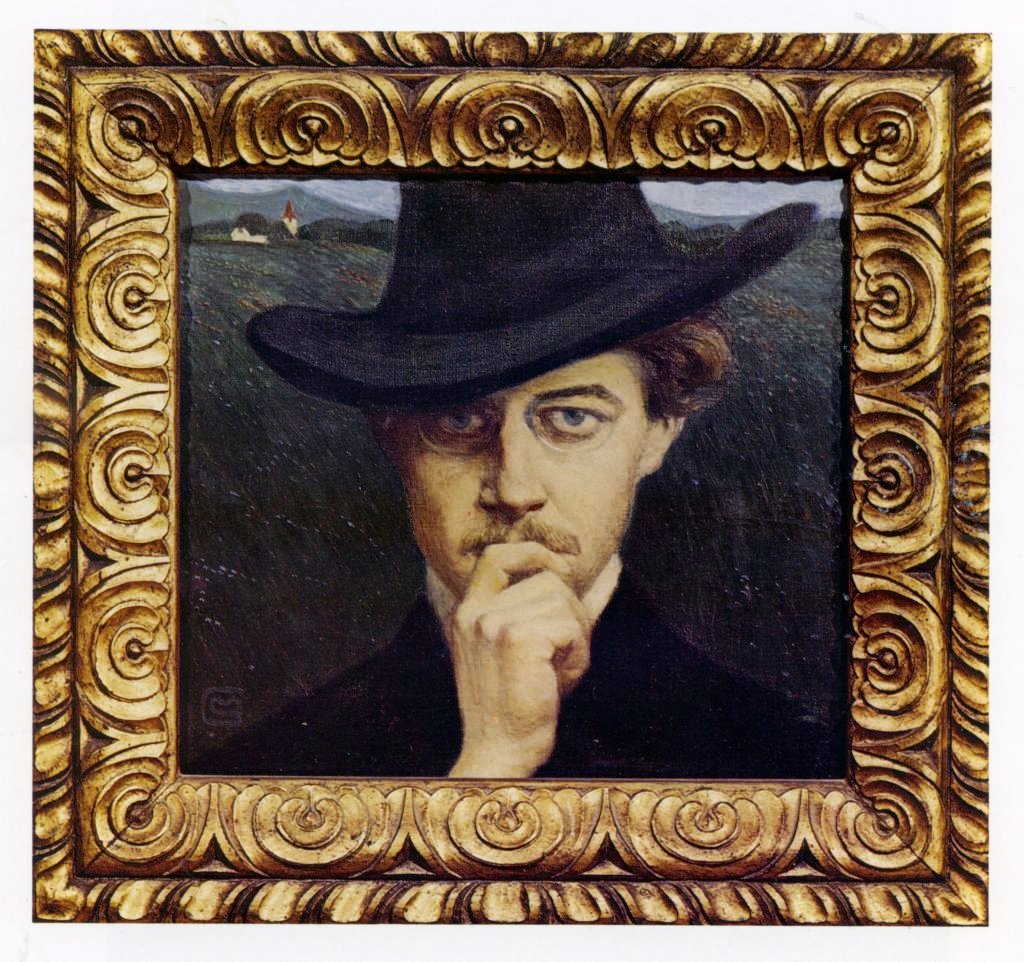
Maksim Gaspari, (1883 – 1980) Slovenian painter and illustrator has been and continues to be immensely popular in his homeland. His is a priceless cultural legacy to Slovenian people, embedded principally in a huge postcard collection. He had created a unique and distinct style, and a pictorial and artistic corpus of work portraying the people of rural Slovenia in the 19th century. He drew Slovenian traditional figures such as shepherds, musicians, beggars, courting couples, Slovenian folk traditions and, festivities and customs. It is a romantic, loving and joyous portrayal, which has retained its charm and popularity in Slovenia into the 21st century. Maksim Gaspari images still appear regularly in calendars and other publications. He has notably illustrated a number of Slovenian literary works.
Maksim Gaspari was born in 1883, in the village Sešček above Cerknica. He was orphaned when attending junior secondary school and was transferred to a school for tradesmen in Kamnik. There his exceptional gift for drawing was noted and he was encouraged to enrol in the school of Applied Arts in Ljubljana. In 1902 Maksim went to Vienna and enrolled in the Graphic Institute. He used his time in Vienna well. Apart from applying himself diligently to his studies, he attended art exhibitions and absorbed the rich artistic life of the vibrant cultural centre of the Austro-Hungarian Empire. He saw exhibitions by the French impressionists and post-impressionists, with special interest in Slovenian impressionist painter Ivan Grohar, and became interested in the unfolding Art Nouveau movement. He particularly liked the paintings by G. Klimt and G. Segantini.
In Vienna Maksim mixed socially with Slovenian and Croatian students at the Vienna Painting Academy, among others G. Birolla, S. Peruzzi, S. Šantel, I. Meštrović. In their company he frequented the newly founded Slovenian Art Society Vesna, whose motto was Iz naroda za narod (From the People for the People).
In 1903 Gaspari enrolled in the Vienna Art Academy and began to study with new vigour. The paintings Zobobol (The Toothache), Škrjanček bo letel (The Lark will fly), The Girl and the Bird among others belong to this period. In 1905 he painted his self-portrait, a mature work of art, reflecting the atmosphere of melancholy. The time he spent in Vienna determined the course of his life as artist.
Due to straightened circumstances he had to discontinue his studies in Vienna, but in 1907 he went to Munich where he undertook further studies and began to work. Here he painted the beautiful Kmečki par (Peasant Couple) and illustrated the collected poems of Slovenian poet Dragotin Kette, which is his first work as illustrator of Slovenian literary works. With this book and subsequently Milčinski’s Fairy Tales in 1911 Gaspari is regarded to have achieved the pinnacle in the art of illustration.
In 1908 Maksim returned to Kamnik where a studio was made available to him by his friend Niko Sadnikar. In 1911 he married and settled in Ljubljana, where he taught art, initially at a secondary school, later at the art school “Pobuda”. In 1928 he was appointed restorer by the Slovene Ethnographic Museum in Ljubljana. These positions ensured a steady income at a time when art alone could not provide livelihood to an artist in Slovenia. This meant that he devoted more time to illustrations, receiving the main stimulus from the Art Nouveau movement. The illustrations to Dragotin Kette’s Collected Poems were soon followed by drawings for The Turks at St. Tillen by Slapšak, then the illustrations of Fran Milčinski’s Fairy Tales, and the novels Deseti brat (The Tenth Brother), Rokovnjači (The Bandits) by Josip Jurčič, Cvetje v jeseni (Autumn Blossoms) by Ivan Tavčar and a great number of other publications, including placards and calendars.
After his Art Nouveau period Gaspari found new inspiration in his awakened patriotism. In 1918, after the conclusion of World War I, and during the period when the Kingdom of Serbs, Croats and Slovenes was created, (later renamed and reconstituted as Yugoslavia), he embarked on his most productive period, reflecting national awakening, the various national movements such as Sokol (Falcon), Orel (Eagle) and Ss. Cyril and Methodius. Among other productions reflecting traditional customs he also created the unique Slovenian Christmas Crib, with the Holy Family and shepherds dressed in traditional Slovenian costumes, and the three wise men appear as Serb, Croat and Slovene, a representation of the newly founded Southern Slavic state. The crib is a celebration of national spirit and has become an enduring testament of the era.
During his lifetime and after his death Maksim Gaspari did not achieve great acclaim for his paintings, although he created several that have ensured his standing as painter, principally his Svatba (The Wedding Feast). His enduring popularity however is due to his creation of what was to become the Slovenian traditional rural style, immortalized primarily in his picture postcards. He portrayed the Slovenian countryside with its distinct buildings, traditional Slovenian costumes and traditonal feasts, such as Easter and Christmas customs, country musicians, country dances, young couples, traditional characters, such as beggars, blacksmiths, and beekeepers, a young mother with the cradle… These are the images which regularly still appear on annual calendars, posters and other publications. There had been a number of exhibitions over the years featuring primarily the postcards. He created picture postcards throughout his life after the first one in 1902, including those he sent to his friends over the years. There is now a collection of 392 prints held by the National and University Library (NUK) in Ljubljana.
Maksim Gaspari was also a well-established illustrator, with numerous books and journals to his credit. For his illustrations of Korney Chukovsky’s Čuri Muri velikan (The Monster Cockroach) he won the Levstik Award in 1949. In 1953 he received the Prešeren Award for his achievements in painting, and in 1972 was accorded the highest honour, membership of the prestigious Slovenian Academy of Arts and Sciences.
He has left a legacy of an extraordinary opus of work. Gaspari illustrated 57 books, especially children’s books, created 33 cover pages for books and magazines, published his work in some 41 newspapers and magazines, produced numerous advertising posters, caricatures, honorary documents and diplomas, signets, pamphlets. His school readers were published from 1912 until World War II. He illustrated among others Kette’s poetry, Milčinski’s Fairy Tales, Slovenian fairy tales, Slovenian ballads and romances…
Today the Gaspari legacy continues to be celebrated. In 2005 there was a major Gaspari exhibition in Bled. The Gaspari Picture Postcard Exhibition has travelled around the world, wherever there were Slovenes: Austria, Germany, France, Belgium, Netherlands, USA, Brasil, Argentina, Uruguay, and throughout eastern Australia (Sydney, Melbourne, Canberra, Bright). The Gaspari calendars are still being published, displaying the joyous images of Slovenian rural culture of the past. In the words of Vera Baloh, the name Maksim Gaspari has become synonymous for Slovenian folklore in visual art, romantically coloured it is true, and endearing but this is precisely how he opened many doors and won a multitude of admirers.
References:
Baloh, Vera, “Maksim Gaspari, ilustrator”, in Maksim Gaspari, 1883-1980, ilustrator : Retospektivna razstava – Katalog (exhibition catalogue), Narodna galerija, 8.oct.-16.nov.1986, Ljubljana.
Bolhar, Alojzij (ed.), Slovenske narodne pravljice, Mladinska knjiga, Ljubljana, 1955.
Marinšek, Marjan, “Maksim Gaspari” Sinfo. Dec. 2004, Government Communication Office, Republic of Slovenia, Ljubljana.
Mesesnel, France: Maksim Gaspari. Slovenski biografski leksikon, electronic ed., SAZU, Ljubljana, 2013.
Mikuž, Dr. Stane, Maksim Gaspari, monografija, Mladinska knjiga, Ljubljana, 1977.
Photo gallery:
- Self-portrait (1905) (lastna podoba)
Source: Mikuž, Stane, Maksim Gaspari…, 1977.
- Inside of cover page of book, D. Kettte, Poezije (1907)
Source: Catalogue, “Ilustrator…”, 1986.
- Illustration for book D. Kette, Poezije (1907)
Source: Catalogue, “Ilustrator…”, 1986.
- Men with fists (1905) (Moža s pestmi)
Source: Catalogue, “Ilustrator…”, 1986.
- Source material for cover of journal Ljubljana Bell (1905) (Ljubljanski Zvon)
Source: Catalogue, “Ilustrator…”, 1986.
- Illustration for book: Josip Jurčič, Tenth Brother (1944) (Deseti brat)
Source: Catalogue, “Ilustrator…”, 1986.


